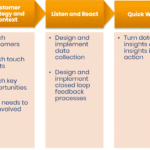I wrote recently about how engineers in process plants are never happy with the status quo. They are always looking for improvements and tweaks to the manufacturing process that can drive incremental improvement in profit and efficiency.
This post is about how you can use Transactional Net Promoter Score® to do the same thing for customer loyalty, through its key driver; customer experience.
Two types of innovation
Lets start by identifying two key types of innovation: discontinuous and incremental.
Discontinuous innovation creates whole new genres or products: think T-Model Ford replacing the horse, the Sony Walkman creating a whole new product category, the IBM PC. Discontinuous innovation generates major leaps forward but is relatively rare and risky.
Incremental innovation slowly but surely improves a product or category. Incremental innovation is how the car went from the T-Model Ford to the F1 racing car we see today. All the key features of the T-Model are present in the F1 racing car, they are just much, much improved. A million small incremental innovations over 80 years has generated a product that is essentially the same but completely different.
The simple truth is that while discontinuous innovation is sexy, it is also risky and rare. Incremental innovation is less exciting but very low risk, and generates enormous value day in and day out.
Driving incremental customer experience innovation
So how do engineers drive incremental innovation? Not by focusing on the whole process but by breaking it down into sub-areas areas and focusing on the worst performing areas first. To identify the worst performing areas, and how to fix them, engineers then use systems that collect thousands of measurements from all over their manufacturing process.
This very same process can be used to drive incremental innovation in your customer experience. Simply swap the industrial manufacturing process for the customer experience (where we manufacture customer loyalty) and the Transactional Net Promoter Score process for the engineer’s temperature and pressure sensors.
From a practical perspective you can achieve this by breaking your customer experience down into distinct touch-points and sub-processes and then apply Transactional Net Promoter Score to collect data at each of the touchpoints.
Start with the worst
Now you have a series of customer experience manufacturing steps, each with it’s own customer experience sensor to collect data about what works and does not work. Using NPS you can now rank the customer experience manufacturing steps from best to worst; highlight the pain points and focus on those areas that most need attention first.
Put simply; the touch-point with the lowest NPS will be the one that is performing the worst, and the one that you need to start work on first.
If you have implemented Transactional Net Promoter Score correctly you will also have a range of other diagnostic information to let you know what is wrong with the touch-point and how to fix it. It is then up to you to apply the current quality system toolkit that your organization uses (Six Sigma, Lean Six Sigma, etc) to take this information and drive change.
Customer Experience a Process not a Project
Once you have improved the worst touch-point you can move on to the second worst touch-point and repeat the process. Now you can see that customer experience is not a project but a process. It is a never ending cycle of incremental innovation that can and will move you a long way from your Model-T customer experience to a Formula 1 customer experience.
Get the Business Leader's Guide to Net Promoter Score Download Here









